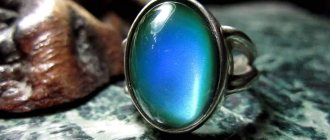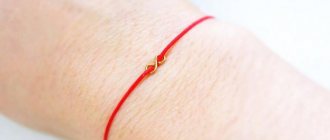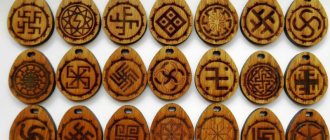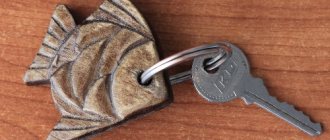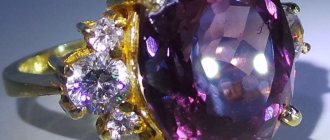What do bracelets on the wrist mean, palmistry: full explanation
The first thing a beginner needs to know is that each of the 3 or 4 roads is responsible for one or another area of life:
- The top one is responsible for health.
- The middle one relates to the area of wealth.
- The last or 3rd is responsible for matters of the heart.
Health line on the wrist
Before you start analyzing your hands, pay attention to the bracelets on your hands. Palmistry lines on the wrists can tell a lot about its owner.
First picture top line
If during analysis it is discovered that the restriction:
- weakly expressed;
- intertwined with small dashes;
- has a wave-like shape;
this indicates problems, both physically and psychologically.
Note. Depending on other lines, it may indicate a difficult life path.
Ideally, the lines and bracelets on the hand should be straight and smooth. This also applies to health restrictions; if she is beautiful, then this indicates a person who is quite successful in mental work.
The first arched rosette
Note. If the first line has the shape of an arch in a woman, this indicates a difficult birth or infertility (if the 2nd bracelet has the same arch).
So what we need to know:
- Fuzzy outline. The opponent has health problems and certain life difficulties.
Advice. You can change your lifestyle a little and pay attention to your physical health.
- Rosetta is perfectly expressed. Everything will be obtained with ease, and luck will accompany the fortuneteller.
Lines, bracelets on the hand: the meaning of the second rosette (financial situation)
The 2nd bracelet on your hand answers all financial questions in life:
- If there are cliffs, a person will face financial problems throughout life. In general, money will be obtained with great difficulty.
Palmistry, wrist bracelets: the meaning of the 2nd road
- If chains or links are visible on the rosette, this speaks of a person who likes to take risks and often fortune smiles on him.
Note. But such a bracelet on the hand (palmistry) also indicates a spender. In general, money comes to him and goes away easily.
- When a split is discovered at the end, the combination indicates sudden wealth, but already in old age.
Third bracelet or spiritual affairs
The third bracelet is responsible for love affairs.
- If the line is clear and even, then there will be mutual great love in your life. In general, the marriage will be prosperous, without quarrels and problems in the relationship.
Lines, bracelets on the right hand (3rd soul trait)
- If a significant distance is found between the 2nd and 3rd bracelet, then the fortuneteller will be married in adulthood. The longer the distance, the later the marriage.
- If the bracelet is interrupted at some stage and then restored again, then a quarrel awaits the opponent followed by a reunification of the relationship.
Note. A cross or a dot on a line on the hand (marriage bracelet) means the loss of a loved one due to illness or death, or maybe he will simply disappear from life forever.
Four bracelets on the wrist, it happens
If you see 4 bracelets on your wrist, palmistry foretells a long, happy life. This combination is extremely rare.
4 lines on the wrist
Note. There are cases when a person has only one trait, there is no need to sound the alarm. For some reason, the remaining lines have not formed, and future life may depend on today's actions and decisions.
BRACELETS. HISTORY, SYMBOLICS AND MEANING OF BRACELETS.
Natural stone bracelets have been a popular accessory since antiquity. In Ancient Greece, the Roman Empire, and Egypt, such a product was worn by wealthy people. At that time, a bracelet made of natural stone was considered not just a decoration, but an amulet that possessed powerful magical energy. According to ancient legends, minerals are able to protect their owner from all sorts of troubles and unpleasant situations, prevent diseases and even change some character traits.
Varieties of modern bracelets Natural stones are used as talismans in our time. Some choose jewelry with them because they believe in their magical properties. Others buy bracelets because they are a fashionable and beautiful accessory that allows them to highlight their individuality.
Shambhala The most popular accessory with natural minerals is the Shambhala bracelet. The name of this decoration comes from the name of the ancient mythical city - Shambhala. According to legends, it was located in the Tibetan mountains. It was simply impossible to get there. He was simultaneously in three dimensions: etheric, physical and astral. Ancient sages found refuge in this city. Even now it is believed that the Shambhala bracelet has magical powers. However, this only applies to those products that contain natural stones.
Slave This is a piece of jewelry consisting of a bracelet and a ring connected to each other by one or more chains. There are options with not one, but two, three and even five rings. The slave bracelet has this name because it consists of many chains. From English “slave” is translated “slave”. There is a version that the slave bracelet was originally a symbol of marriage in India. Brides wore it on their wedding day and then wore this decoration without taking it off. And over time, it became just a beautiful accessory and spread to other countries of the world. It was especially fashionable in the USA. The first wave of interest in this decoration occurred in the 1920s. Over time, slave bracelets lost their popularity. However, in the 1960s they became popular again - mainly among hippies.
Are bracelets an accessory for your hand? Some may find this question ridiculous. “What else can you wear such jewelry on?” - they will think. But the answer may surprise you: in the modern world, ankle bracelets are becoming increasingly popular. Despite the apparent novelty, this decoration has a rich history. Anklets were already popular among the ancient Sumerians. This is a civilization that lived on the territory of modern Mesopotamia 4.5 thousand years ago. Such an accessory testified to the high financial status of the husband of the ancient Sumerian woman. Later this decoration spread to Egypt, Persia and other countries. In modern fashion, ankle bracelets are an original accessory with which you can emphasize your uniqueness and sexuality.
The meaning of jewelry A bracelet made of natural stone is not just a trinket. This is especially true for Shambhala, as it has strong magical properties. Each mineral has its own energy and can significantly affect a person’s destiny. Therefore, when choosing, you should take into account your zodiac sign, character traits, marital status and other factors.
HOROSCOPE STONES for Aries: amethyst, garnet, coral, hematite, lapis lazuli, carnelian, agate, chalcedony, ruby, labradorite, rock crystal, turquoise, malachite, pyrite, sunstone, amazonite, chalcedony, amber
HOROSCOPE STONES for Taurus: agate, rose quartz, coral, peridot, volcanic lava, lapis lazuli, malachite, carnelian, tiger's eye, moonstone, chalcedony, jasper, rhodonite, chrysoccola, garnet, amazonite, smoky quartz, chalcedony, aquamarine
HOROSCOPE STONES for Gemini: agate, amethyst, volcanic lava coral, lapis lazuli, carnelian, tiger's eye, rock crystal, citrine, rhodonite, pearl, turquoise, malachite, pyrite, amazonite, amber
HOROSCOPE STONES for Cancer : agate, amethyst, amazonite, hematite, emerald, volcanic lava, coral, rose quartz, moonstone, carnelian, rhodonite, ruby, pearl, turquoise, chrysoccola, smoky quartz, chalcedony, aquamarine, amber, jasper
HOROSCOPE STONES for Leo : agate, amethyst, garnet, hematite, coral, lapis lazuli, emerald, carnelian, peridot, rock crystal, rhodonite, citrine, ruby, chrysoccola, jasper, malachite, sunstone, amazonite, smoky quartz, aquamarine, amber
HOROSCOPE STONES for Virgo : agate, amethyst, garnet, coral, carnelian lapis lazuli tiger eye rhodonite rock crystal chalcedony citrine jasper amazonite mucaite amber
HOROSCOPE STONES for Libra : agate, amethyst, smoky quartz, rose quartz, coral, lapis lazuli, malachite, carnelian, peridot, rock crystal, rhodonite, citrine, jasper, pearl, turquoise, chrysoccola, sunstone, amazonite, chalcedony, mucaite, aquamarine, amber
HOROSCOPE STONES for Scorpio : agate, amazonite, amethyst, hematite, garnet, smoky quartz, coral, lapis lazuli, volcanic lava, labradorite, rhodonite, jasper, pearls, rock crystal, turquoise, pyrite, sunstone, chalcedony, aquamarine, amber
HOROSCOPE STONES for Sagittarius: agate, amethyst, garnet, hematite, emerald, coral, lapis lazuli, rose quartz, carnelian, peridot, tiger's eye, chalcedony, rhodonite, ruby, jasper, malachite turquoise, chrysoccola, pyrite, sunstone, amazonite, smoky quartz, chalcedony, mucaite, amber
HOROSCOPE STONES for Capricorn : agate, amethyst, garnet, volcanic lava, coral, malachite, quartz, carnelian, tiger's eye, chalcedony, ruby, jasper, pearl, turquoise, sunstone, amazonite, chalcedony, amber, hematite
HOROSCOPE STONES for Aquarius : agate, amethyst, coral, emerald, lapis lazuli, rhodonite, carnelian, tiger's eye, rock crystal, citrine, jasper, pearl, turquoise, malachite, chrysoccola, sunstone, amazonite, smoky quartz, chalcedony, aquamarine, amber
HOROSCOPE STONES for Pisces : agate, amethyst, coral, lapis lazuli, carnelian, emerald, chalcedony, rhodonite, tiger's eye, pearls, rock crystal, malachite, amazonite, smoky quartz, chalcedony, mucaite, aquamarine, amber
Palmistry on hand bracelets: full decoding
| All roads are smooth | Such a hand indicates a happy, financially secure, prosperous person. |
| This is what wrist bracelets look like, palmistry with interlacing | If there are no clear boundaries and you see numerous intertwinings, then the owner has strong health, but often experiences difficulties. |
| Restricted with upward bend | If such a combination is observed in a woman with an upward curve, this indicates a difficult birth and problems with childbirth in general. For men, this is a ban on heirs. If the same combination is observed on the left hand, then the problem is at the karmic level. If only on the right, then the fortuneteller must realize all his sins and move on. |
| Availability of an island | When line bracelets on a hand meet with an island, this indicates a problem through which a woman cannot conceive a child. In this case, it is recommended to analyze your life and determine where the problem lies. An island on both hands indicates a problem at the genetic level. If only on the right, then the problem appeared during life. |
| Palm fortune telling, interruption bracelets | If the line is intermittent, then in front of you is a person who is constantly experiencing financial difficulties. From time to time, a fortuneteller falls into a debt trap. Such people find it difficult to stabilize their financial situation. |
| Road in the form of a chain | This combination characterizes a risky person. The opponent knows how to earn money and this brings him joy, but he spends it with the same ease. |
| Bracelets on the hand, the lines are smooth and straight | The marriage line is straight and even, before you is a loving person. At the same time, everything in his life is mutual. Everything is fine in love affairs; nothing can stop you from being happy. |
| Distance between roads | If the bracelets (palmistry) are located far from each other, then a late marriage awaits the fortuneteller. |
| The restriction is broken | Indicates a quarrel or divorce. If the bracelet is restored, then the marriage will be restored. |
| Palmistry, bracelets on hands with signs | If a hash mark or cross is found on the bracelet, it indicates the loss of a loved one. Sometimes leaving the family forever, or some terrible illness will take him away from the family. |
| Four roads | An excellent combination that indicates a long good life. |
Warrior spirit
Lenta.ru continues a series of publications about the history of different types of clothing and accessories. In the previous materials of the series we talked about heels, a miniskirt, a men's dress, a suit, a tie, tights and a down jacket. A new article is about the history of the bracelet, which turned from armor into jewelry.
Bracelets are one of the very first jewelry in human history. Even ancient people decorated their wrists with strips of leather and animal sinew, on which beads made from animal fangs or stones with natural holes were strung. Initially, as anthropologists believe, bracelets played the role of mystical amulets, and not just cute trinkets, but over time these roles merged into a single one - amulets-decorations.
In ancient times, for men, a hoop bracelet (this word linguistically comes from the expression “in the hand”, “on the hand”) also had a practical meaning. Wide bracelets protected the wrist, which was vulnerable in battle or hunting, from blows from cold weapons and the teeth of predatory animals (just as greaves protected calves and ankles). Nowadays, a wide jewelry bracelet, shaped like this piece of armor, is called a cuff in English. This word recently appeared in Russian - “kaff”.
Gradually, with the transition from the Neolithic to the Bronze and Iron Ages, people acquired and accumulated metal processing skills. This was accompanied by an increasingly clear division of people into the rich, those in power, and the poor commoners. The rich no longer wore rough, savage men's bracelets made from simple stones or shells, or wide strips of thick rawhide.
Aristocratic warriors decorated themselves in battle with luxurious items of almost jewelry level made of bronze or damask steel with gold and silver notches, decorated as exquisitely as all their armor. In the Middle Ages, such bracelets among Byzantine emperors, kings and princes finally lost their practical role. They were made of gold and precious stones and were worn as part of ceremonial dress to demonstrate high status.
For women, bracelets, of course, were not armor: rather a talisman and, like men, a way of demonstrating status and wealth. In ancient India, bracelets played the role of a wedding ring, signaling a woman's marital status. There is a legend that among the Bedouins, nomadic tribes of the Middle East, a husband could divorce his wife and expel her with the property that was on her. This is supposedly why Bedouin women traditionally wear many silver or gold (depending on their wealth) bracelets on both hands.
1/2
Moreover, in the old days, not all women had bracelets. In those cultures where clothes with long sleeves were adopted, the role of a bracelet was performed by decorations on the shirt fabric. For wealthy women, the sleeves of their holiday dresses were embroidered with gold embroidery, pearls, and pieces of more expensive fabric (for example, brocade) were sewn onto them. Poor girls embroidered the sleeves of their shirts with colored threads.
In Europe, bracelets entered (or returned) into aristocratic fashion around the 17th century, along with the fashion for dresses with sleeves shortened by three-quarters, or dresses that left the arms completely bare. This fashion appeared in Europe earlier than in Russia. In our country, women began to bare their arms under Peter I, who introduced Western European customs.
As a rule, such outfits were worn by rich aristocrats (and later, in the mid-19th century, representatives of the wealthy bourgeoisie) on special occasions: at balls, evening receptions, at court. The Empire style, which spread in Europe and at the Russian court at the very end of the 18th century, introduced fashion not only for short sleeves of high-waisted dresses “in the Greek style”, but also for “Greek” bracelets in the form of snakes entwined around the wrist. Such decoration, reminiscent of the legend of Queen Cleopatra, can be seen in the portrait of Grand Duchess Elena Pavlovna by Bryullov.
1/2
Evening fashion in the 19th and early 20th centuries included cuff cuffs or wide flexible bracelets with a clasp. They were part of the parure (a complete evening set of decorations). In addition to the bracelet, the parure included a ring, necklace, earrings and hair decoration (tiara or diadem) of the same design. For the parure, only gold (sometimes there were platinum parts), precious stones and pearls were used.
At the end of the century before last, women (by the way, earlier than men) began to wear watches on bracelets. The evening watch is just a cuff bracelet, in which the dial is most often hidden. A real breakthrough for jewelry watches was the invention in 1929 by watchmakers of the Swiss manufactory Jaeger-LeCoultre of the Caliber 101 mechanism, which weighed about a gram. From that moment on, watches in evening bracelets became almost invisible. In 1953, the British Queen Elizabeth II wore exactly this model to her wedding.
After the First World War, almost all the rigid conventions of women's fashion of previous centuries became a thing of the past. Women, even wealthy ones, were able to wear not only unpretentious short skirts and trousers, but also inexpensive costume jewelry, a taste for which was instilled in them, in particular, by Chanel, who often wore large cuff bracelets with eight-pointed crosses made by the aristocratic master Duke Fulco di Verdura.
1/3
Economic crises led to an increase in gold prices, which is why even the fashionable jewelry house Van Cleef & Arpels offered its clients bracelets made of bakelite, ivory and ebony, very moderately inlaid with gold, enamel, mother-of-pearl and semi-precious stones.
As soon as the financial situation improved, jewelers from haute joaillerie houses resumed working with precious metals, diamonds and rare colored stones. In 1932, Chanel herself briefly changed her passion for costume jewelry and released a jewelry collection made of white gold and diamonds with motifs of comets and feathers.
The tone for jewelry fashion in the interwar period was set by the Duchess of Windsor, Wallis Simpson. The wife of the abdicated British King Edward VIII loved bracelets: they emphasized the thinness of her wrists. Wallis wore chalcedony bracelets from ahead of her time jewelry designer Suzanne Belperron.
The Duchess did a lot to popularize the Panthère de Cartier motif. The panther was also invented by a woman - the creative director of the Cartier house Jeanne Toussaint, a contemporary of Simpson. Among other creations at home, the Duchess of Windsor had a bracelet in the shape of a panther, covered with diamonds. Because Simpson was imitated by many, the wild cat jewelry became a huge hit and remains so to this day.
The post-war period became a triumphant time for the American house Tiffany & Co. The mid-twentieth century marked the era of the famous jeweler Jean Michel Schlumberger. He made luxurious evening bracelets with precious stones: lush, but not kitsch. The motif of a “jewelry bestiary” set by Toussaint—jewelry depicting animals—was vividly developed by Van Cleef & Arpels and another French house, Boucheron, in the middle of the century. The beauty of these statement pieces, which are still popular today, is that the chunky bracelets look “cartoonish” but are made of gold and precious stones. Therefore, jewelry “animals” from Boucheron or de Grisogono are quite appropriate for a cocktail or evening reception.
The tone in classic evening jewelry fashion of the 20th and 21st centuries was set by luxury companies that rethought the heritage of past centuries. The Japanese house Mikimoto, a pioneer in the use of cultured pearls, has brought back into fashion the rocaille bracelets made from several strings of pearls with ornate diamond clasps, which were popular back in the 18th century. A string of pearl bracelet received its own name in English: pearl bracelet.
1/4
Another originally rocaille motif, the bow, is repeated in different versions in bracelets of many luxury brands: magnificent at Dior Joaillerie, laconic at Chaumet. High jewelery artists were followed by premium brands. Bows began to be made not only with diamonds, but also with Swarovski crystals. This bracelet looks good with a cocktail dress that completely reveals your arms: then the attention of others is focused on this catchy and flirty decoration.
The sexual revolution of the late 1960s became the starting point of the fascination with ethnic and psychedelic drugs in Europe and the USA. The boho style, the most popular among the informals of the 1970s and their sympathizing bohemians and even young people from respectable circles, meant bracelets. Many different bracelets.
The most famous, even in our country, type of “hippie” bracelets are friendship bracelets woven from threads or beads (in the USSR and Russia they were called “baubles”). Yoga enthusiasts had bead bracelets, models reminiscent of Buddhist rosaries made of round beads or rectangular plates with ornamental engraving (now they are popular again). The most versatile are bangle bracelets. These are wide rings made of thin metal strips, as if made of silver or gold by Arab, Indian or Thai artisans. They were worn, imitating the authentic style of Indian and Bedouin women, several pieces on one wrist.
It was these models that jewelry designer Aldo Cipullo was inspired by when he made his LOVE bracelet for the house of Cartier in 1969. In addition to the allusion to ethnic style, it also contained a love secret: the bracelet can only be removed with a special screwdriver. Chippulo's creation resembled an affirmation bracelet (a Bangla version with inscriptions and symbols, such as on traditional Georgian prayer bracelets).
LOVE in different variations (different widths, gold of different colors, with diamond pavé) remains the brand's bestseller for almost half a century. This is one of the most famous jewelry of the twentieth century. All Instagram stars have it, including Kim Kardashian and Bella Hadid.
1/6
The legacy of the 1960s and 1970s is not limited to Bangla. At the same time, wide, laconic cuffs and leather “belt” bracelets with buckles, which were worn over the sleeves of thin turtleneck jumpers, came into fashion. From India, hippies literally brought kilograms of so-called wooden bracelet (jewelry carved from a piece of wood) and hololith bracelet (the same, but made of ornamental stones: onyx, carnelian). They were worn with dresses in the safari style, which is associated with the legacy of the young Yves Saint Laurent and is now popular, like everything vintage.
The eighties of the last century are remembered by many as an era of material well-being and prosperity. It is not surprising that rich women then wore diamonds not only to formal receptions, but also to the tennis court. American houses Harry Winston and the already mentioned Tiffany & Co. made laconic track bracelets made of large diamonds popular.
They were called tennis bracelet: they were worn by tennis stars of the 1980s and 1990s, including Anna Kournikova, the first Russian tennis player to gain fame in the West. In addition to diamonds, other precious stones (rubies, sapphires, emeralds) of classical cuts, mainly round and baguette, were used for such models. These bracelets soon began to be worn at black tie ceremonies and cocktail parties, combined with sheath dresses or open designer tops.
In general, in the penultimate decade of the twentieth century, the American spirit of prosperity and exclusivity set the tone in costume jewelry and jewelry. Massive chain bracelets (for example, from Pomellato), cuffs with large colored stones, like those from Bvlgari, were in fashion. Large, expensive-looking jewelry with polished finishes in different shades of gold and colored Swarovski crystals has become popular again. These things seemed to communicate the wealth and determination of their owner - as assertive as the heroine of the series “Dynasty” Alexis Colby played by Joan Collins.
The 1990s brought biomorphic jewelry into jewelry style. Wide detachable or solid cuffs, as well as rigid bracelets fastened with a chain, resemble a fragment of coral, stingray skin or some kind of alien substance (as well as Hundertwasser architecture). Such things are made, in particular, by the Italian house Antonini. Deconstructivist architectural designs with broken edges and whimsically piled-up volumes also found a place in jewelry. These are bracelets designed by Pritzker-winning architect Frank Gehry for Tiffany & Co. and Zaha Hadid for Georg Jensen.
The minimalism of the 1990s found a new breath in the 2010s: daytime or costume jewelry is often made emphatically geometric and light. Bangle bracelets, reminiscent of finely drawn gold frames on the skin, with diamonds or cubic zirconia and pearls. Thread bracelets modeled on the Kabbalistic red thread (which, by the way, was brought into fashion by Madonna when she became interested in Kabbalah). Chain bracelet - chains without decorative elements, either with round or baroque pearls, which can be worn one at a time or several at a time.
This trend marked the beginning of the modern fashion for “memory jewelry” or “emotion journal jewelry,” which is loved by both young teenage girls and older women. Many brands produce bracelets with removable charms (charm bracelets). These are souvenirs in memory of significant events in the life of the owner of the jewelry. The Eiffel Tower reminds you of a trip to Paris, a child figurine reminds you of the birth of a baby, and a heart reminds you of a romantic date. These bracelets show that these days the most important thing in jewelry is not its cost, but the memories it brings back.
Rosary bracelets. Bead bracelets.
Many fashionistas know that this is not the first season that ball bracelets have been in fashion.
The founder of this trend was the former agent of Hollywood stars Loree Rodkin; today she is already a designer of various accessories. It was thanks to this fashionable, extravagant woman that the rich and famous, without regret, exchanged their vintage diamonds for Indian bracelets - rosary beads made of turquoise and other materials. After conquering bohemian America, the designer decided to become the darling of her country's political elite and almost immediately found herself working as Michelle Obama's chief jewelry designer. America's First Lady chooses Laurie Rodkin bracelets for her most important interviews and major special occasions. Bracelets - rosary beads really look very good with jewelry and costume jewelry, while harmoniously complementing each other.
Therefore, for those who have not yet added a bracelet made of balls to their jewelry box, we recommend paying attention to this particular model. The main beauty of bead bracelets is that you can use your imagination and show your individuality and creativity.
Fashion bracelet 2012
Today no one considers the bracelet an amulet or an aristocratic symbol; the bracelet has become a simple accessory.
Many women have dozens of bracelets in their jewelry box for all occasions. And, of course, it is very strange to imagine that the curls of her loved one are hidden in the pendant that is fastened to your friend’s jewelry. A modern bracelet is the result of exquisite design and craftsmanship. It has always served as an object of close attention; jewelry is created for this purpose. Every fashionable jewelry house necessarily includes it in its line of jewelry. Previously, ladies were shocked by the size of the diamond. Now the emphasis is on non-standard design materials.
This year, the most incredible combinations are very popular: many bracelets, thin and wide, on one hand of different colors are considered popular. Bracelets made of leather, straw, bone, varnish and enamel are also very common.
Materials in bracelets
As we have already said, hand amulets can be made from any materials. Bracelets made of gold and silver are especially worthy of mention. Even in ancient times they were credited with enormous magical powers.
Gold is associated with the Sun, silver with the Moon. Silver amulets were credited with the ability to ward off evil spirits. To this day, crosses and body icons are very often made from silver. Many rituals required silver ritual utensils. Nowadays, silver and gold talismans are still considered very powerful.
If the gold or silver amulets bracelets on your hand begin to darken, this indicates that they have collected too much negative energy.
In order to cleanse the talisman, choose the right time. For silver it is the waxing moon, for gold it is the dawn. Place the amulet in salted water and leave for a day, after which drain the water away from your home.
Popular materials are also stones and genuine leather. For a stone bracelet, you need to select several smooth stones of the same size, on which runes or other protective symbols can be inscribed.
